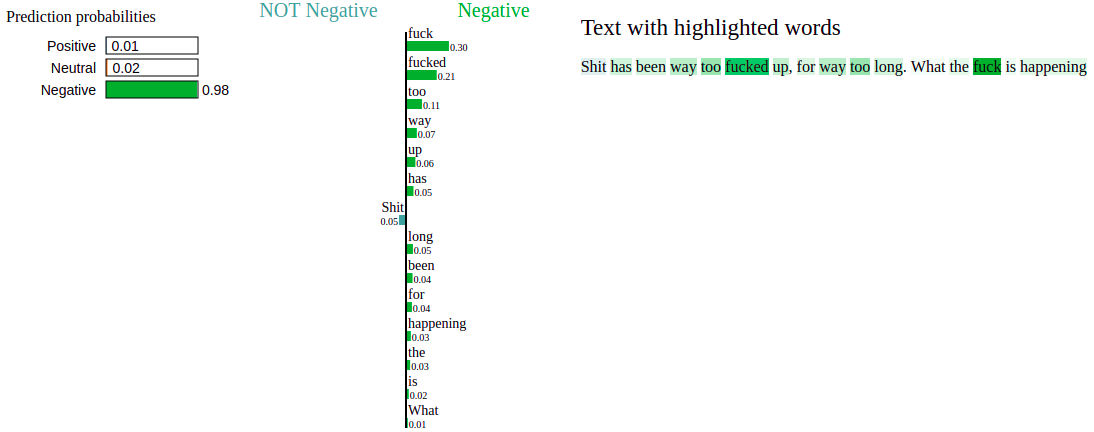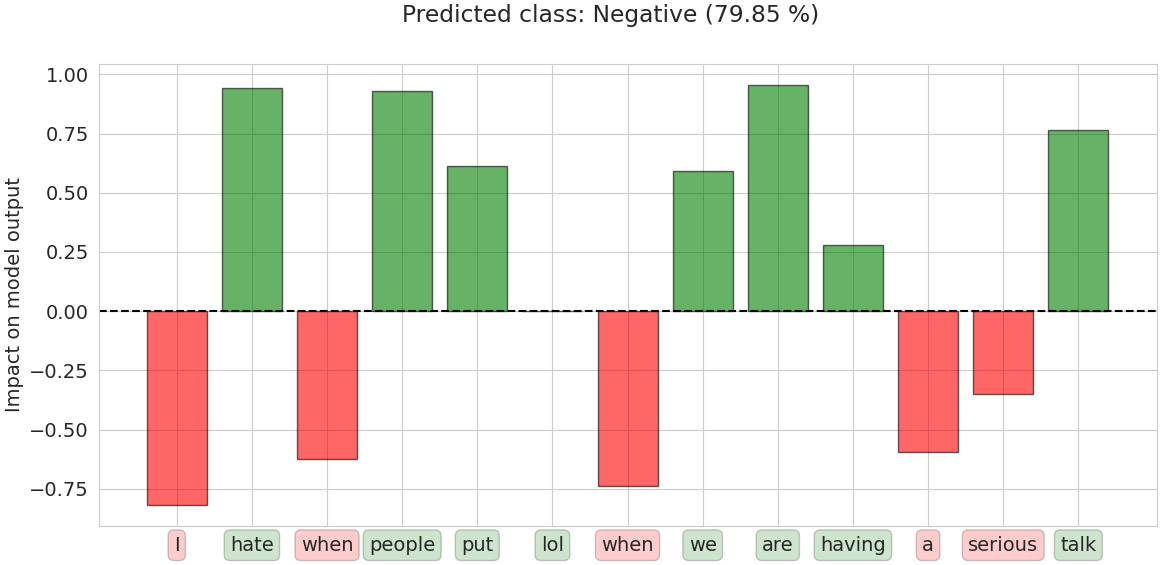(a, b) Interpreting the BERT model with explanation methods LIME (https://github.com/marcotcr/lime) and SHAP (https://github.com/slundberg/shap) using their visualization approach, and (c) generating explanations with Kernel SHAP and using our visualization approach (TransSHAP visualizer) to make it more intuitive for textual data.
from transformers import BertTokenizer, BertForSequenceClassification
import numpy as np
import pandas as pd
from nltk.tokenize import TweetTokenizer
import random
import logging
logging.basicConfig(format='%(asctime)s - %(message)s', datefmt='%d-%b-%y %H:%M:%S')
logging.getLogger().setLevel(logging.INFO)
class SCForShap(BertForSequenceClassification):
def __init__(self, config):
super().__init__(config)
def forward(self, input_ids=None, attention_mask=None, token_type_ids=None, position_ids=None, head_mask=None, inputs_embeds=None, labels=None,):
output = super().forward(input_ids, attention_mask, token_type_ids, position_ids, head_mask, inputs_embeds, labels)
return output[0]
# Load pre-trained model tokenizer
pretrained_model = "./models/en_balanced_bertbase-g512-epochs3/"
tokenizer = BertTokenizer.from_pretrained(pretrained_model, do_lower_case=False)
model = SCForShap.from_pretrained(pretrained_model)
# Test texts
t1 = "Why is it that 'fire sauce' isn't made with any real fire? Seems like false advertising." #neutral
t2 = "Being offensive isn't illegal you idiot." #negative
t3 = "Loving the first days of summer! <3" #positive
t4 = "I hate when people put lol when we are having a serious talk ." #negative
t5 = "People are complaining about lack of talent. Takes a lot of talent to ignore objectification and degradation #MissAmerica" #neutral
t6 = "@Lukc5SOS bc you're super awesome😉" #positive
t7 = "RT @JakeBoys: This show is amazing! @teenhoot family are insane 😍" #positive
t8 = "So kiss me and smile for me 😊💗 http://t.co/VsRs8KUmOP"
t9 = "Shit has been way too fucked up, for way too long. What the fuck is happening" #negative
texts = [t1, t2, t3, t4, t5, t6, t7, t8, t9]
# Bag of words (vocabulary)
train_data = pd.read_csv("./models/English_tweet_label.csv")
train_data = list(train_data["Tweet text"])
tknzr = TweetTokenizer()
bag_of_words = set([xx for x in train_data for xx in tknzr.tokenize(x)])from lime.lime_text import LimeTextExplainer
from explainers.LIME_for_text import LIMExplainer
predictor = LIMExplainer(model, tokenizer)
label_names = ["Positive", "Neutral", "Negative"]
explainer = LimeTextExplainer(class_names=label_names, split_expression=predictor.split_string)
to_use = texts[-2:]
for i, example in enumerate(to_use):
logging.info(f"Example {i+1}/{len(to_use)} start")
temp = predictor.split_string(example)
exp = explainer.explain_instance(text_instance=example, classifier_fn=predictor.predict, num_features=len(temp))
logging.info(f"Example {i + 1}/{len(to_use)} done")
words = exp.as_list()
#sum_ = 0.6
#exp.local_exp = {x: [(xx, yy / (sum(hh for _, hh in exp.local_exp[x])/sum_)) for xx, yy in exp.local_exp[x]] for x in exp.local_exp}
exp.show_in_notebook(text=True, labels=(exp.available_labels()[0],))LIME explanations for positive (top) and negative (bottom) sentiment:


import shap
from explainers.SHAP_for_text import SHAPexplainer
logging.getLogger("shap").setLevel(logging.WARNING)
shap.initjs()
words_dict = {0: None}
words_dict_reverse = {None: 0}
for h, hh in enumerate(bag_of_words):
words_dict[h + 1] = hh
words_dict_reverse[hh] = h + 1
predictor = SHAPexplainer(model, tokenizer, words_dict, words_dict_reverse)
train_dt = np.array([predictor.split_string(x) for x in np.array(train_data)])
idx_train_data, max_seq_len = predictor.dt_to_idx(train_dt)
explainer = shap.KernelExplainer(model=predictor.predict, data=shap.kmeans(idx_train_data, k=50))
texts_ = [predictor.split_string(x) for x in texts]
idx_texts, _ = predictor.dt_to_idx(texts_, max_seq_len=max_seq_len)
to_use = idx_texts[-1:]
shap_values = explainer.shap_values(X=to_use, nsamples=64, l1_reg="aic")
len_ = len(texts_[-1:][0])
d = {i: sum(x > 0 for x in shap_values[i][0, :len_]) for i, x in enumerate(shap_values)}
m = max(d, key=d.get)
print(" ".join(texts_[-1:][0]))
shap.force_plot(explainer.expected_value[m], shap_values[m][0, :len_], texts_[-1:][0])SHAP explanations for positive (top) and negative (bottom) sentiment:


from explainers import visualize_explanations
text = texts_[-1:]
to_use = idx_texts[-1:].reshape(1, -1)
f = predictor.predict(to_use)
pred_f = np.argmax(f[0])
visualize_explanations.joint_visualization(text[0], shap_values[pred_f][0, :len(text[0])], ["Positive", "Neutral", "Negative"][int(pred_f)], f[0][pred_f], -1)An example of our approach to visualization of prediction explanations for negative sentiment:
If you use this work, please cite KOKALJ, Enja, ŠKRLJ, Blaž, LAVRAČ, Nada, POLLAK, Senja, ROBNIK ŠIKONJA, Marko. BERT meets Shapley : extending SHAP explanations to transformer-based classifiers. In: TOIVONEN, Hannu (ed.), BOGGIA, Michele (ed.). EACL hackashop on news media content analysis and automated report generation : proceedings. Stroudsburg: Association for Computational Linguistics = ACL, pp. 16-21. https://www.aclweb.org/anthology/2021.hackashop-1.3.pdf.
